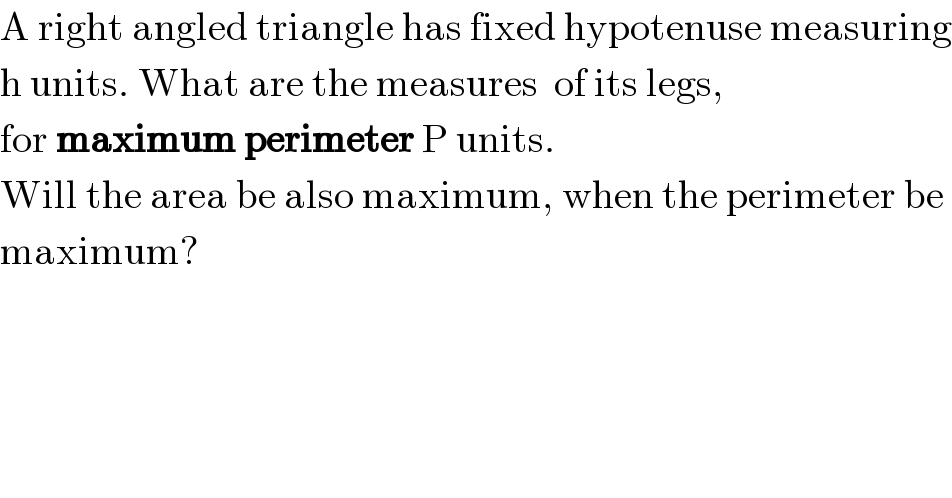Question Number 1611 by Rasheed Soomro last updated on 26/Aug/15

$$\mathrm{A}\:\mathrm{right}\:\mathrm{angled}\:\mathrm{triangle}\:\mathrm{has}\:\mathrm{fixed}\:\mathrm{hypotenuse}\:\mathrm{measuring} \\ $$$$\mathrm{h}\:\mathrm{units}.\:\mathrm{What}\:\mathrm{are}\:\mathrm{the}\:\mathrm{measures}\:\:\mathrm{of}\:\mathrm{its}\:\mathrm{legs}, \\ $$$$\mathrm{for}\:\boldsymbol{\mathrm{maximum}}\:\boldsymbol{\mathrm{perimeter}}\:\mathrm{P}\:\mathrm{units}. \\ $$$$\mathrm{Will}\:\mathrm{the}\:\mathrm{area}\:\mathrm{be}\:\mathrm{also}\:\mathrm{maximum},\:\mathrm{when}\:\mathrm{the}\:\mathrm{perimeter}\:\mathrm{be} \\ $$$$\mathrm{maximum}? \\ $$
Commented by Rasheed Soomro last updated on 28/Aug/15
![Let the measures of legs are a and b in general and A and B in case perimeter is maximum: A+B+h ≥ a+b+h ∀ a,b∈R^+ ⇒A+B ≥ a+b ⇒(A+B)^2 ≥(a+b)^2 [ ∵ A,B,a,b >0] ⇒A^2 +B^2 +2AB ≥a^2 +b^2 +2ab.......................(I) But A^2 +B^2 =a^2 +b^2 [=h^2 ]................................(II) Subtracting (II) from (I) and then dividing by 2: AB ≥ ab (1/2)AB≥(1/2)ab (((Area of right angled triangle)),((with fixed hypotenuse h units)),((having maximum perimeter)) ) ≥ (((Area of any right angled)),((triangle with)),((fixed hypotenuse h units)) ) This answers second part of the Question.](https://www.tinkutara.com/question/Q1642.png)
$${Let}\:{the}\:{measures}\:{of}\:{legs}\:{are}\:\mathrm{a}\:{and}\:\mathrm{b}\:{in}\:{general} \\ $$$${and}\:\mathrm{A}\:{and}\:\mathrm{B}\:{in}\:{case}\:{perimeter}\:{is}\:{maximum}: \\ $$$$\:\:\:\:\:\:\:\:\:\:\:\mathrm{A}+\mathrm{B}+\mathrm{h}\:\geqslant\:\mathrm{a}+\mathrm{b}+\mathrm{h}\:\:\forall\:\mathrm{a},\mathrm{b}\in\mathbb{R}^{+} \\ $$$$\:\:\:\:\:\:\:\:\Rightarrow\mathrm{A}+\mathrm{B}\:\geqslant\:\mathrm{a}+\mathrm{b} \\ $$$$\:\:\:\:\:\:\:\:\Rightarrow\left(\mathrm{A}+\mathrm{B}\right)^{\mathrm{2}} \geqslant\left(\mathrm{a}+\mathrm{b}\right)^{\mathrm{2}} \:\:\:\:\:\:\left[\:\:\because\:\mathrm{A},\mathrm{B},\mathrm{a},\mathrm{b}\:>\mathrm{0}\right] \\ $$$$\:\:\:\:\:\:\:\:\Rightarrow\mathrm{A}^{\mathrm{2}} +\mathrm{B}^{\mathrm{2}} +\mathrm{2AB}\:\geqslant\mathrm{a}^{\mathrm{2}} +\mathrm{b}^{\mathrm{2}} +\mathrm{2ab}…………………..\left(\boldsymbol{\mathrm{I}}\right) \\ $$$$\:\:\:\:\:{But}\:\:\:\:\:\mathrm{A}^{\mathrm{2}} +\mathrm{B}^{\mathrm{2}} =\mathrm{a}^{\mathrm{2}} +\mathrm{b}^{\mathrm{2}} \:\left[=\mathrm{h}^{\mathrm{2}} \:\right]…………………………..\left(\boldsymbol{\mathrm{II}}\right) \\ $$$$\:\:\:\:\:{Subtracting}\:\left(\boldsymbol{\mathrm{II}}\right)\:{from}\:\left(\boldsymbol{\mathrm{I}}\right)\:{and}\:{then}\:{dividing}\:{by}\:\mathrm{2}: \\ $$$$\:\:\:\:\:\:\:\:\:\:\:\:\:\:\:\:\:\:\:\:\:\:\:\:\:\:\:\:\:\mathrm{AB}\:\geqslant\:\mathrm{ab} \\ $$$$\:\:\:\:\:\:\:\:\:\:\:\:\:\:\:\:\:\:\:\:\:\:\:\:\:\:\:\:\frac{\mathrm{1}}{\mathrm{2}}\mathrm{AB}\geqslant\frac{\mathrm{1}}{\mathrm{2}}\mathrm{ab} \\ $$$$\begin{pmatrix}{\mathrm{A}{rea}\:{of}\:{right}\:{angled}\:{triangle}}\\{{with}\:{fixed}\:{hypotenuse}\:\mathrm{h}\:\mathrm{units}}\\{{having}\:{maximum}\:{perimeter}}\end{pmatrix}\:\geqslant\begin{pmatrix}{{Area}\:{of}\:{any}\:\:{right}\:{angled}}\\{{triangle}\:{with}}\\{{fixed}\:{hypotenuse}\:\mathrm{h}\:\mathrm{units}}\end{pmatrix}\: \\ $$$$\boldsymbol{\mathrm{This}}\:\boldsymbol{\mathrm{answers}}\:\boldsymbol{\mathrm{second}}\:\boldsymbol{\mathrm{part}}\:\boldsymbol{\mathrm{of}}\:\boldsymbol{\mathrm{the}}\:\boldsymbol{\mathrm{Question}}. \\ $$
